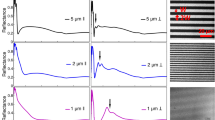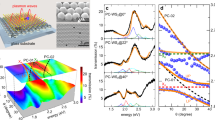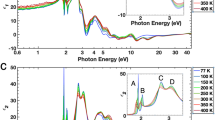Abstract
The interest in plasmonic technologies surrounds many emergent optoelectronic applications, such as plasmon lasers, transistors, sensors and information storage. Although plasmonic materials for ultraviolet–visible and near-infrared wavelengths have been found, the mid-infrared range remains a challenge to address: few known systems can achieve subwavelength optical confinement with low loss in this range. With a combination of experiments and ab initio modelling, here we demonstrate an extreme peak of electron mobility in Dy-doped CdO that is achieved through accurate ‘defect equilibrium engineering’. In so doing, we create a tunable plasmon host that satisfies the criteria for mid-infrared spectrum plasmonics, and overcomes the losses seen in conventional plasmonic materials. In particular, extrinsic doping pins the CdO Fermi level above the conduction band minimum and it increases the formation energy of native oxygen vacancies, thus reducing their populations by several orders of magnitude. The substitutional lattice strain induced by Dy doping is sufficiently small, allowing mobility values around 500 cm2 V−1 s−1 for carrier densities above 1020 cm−3. Our work shows that CdO:Dy is a model system for intrinsic and extrinsic manipulation of defects affecting electrical, optical and thermal properties, that oxide conductors are ideal candidates for plasmonic devices and that the defect engineering approach for property optimization is generally applicable to other conducting metal oxides.
This is a preview of subscription content, access via your institution
Access options
Subscribe to this journal
Receive 12 print issues and online access
$259.00 per year
only $21.58 per issue
Buy this article
- Purchase on Springer Link
- Instant access to full article PDF
Prices may be subject to local taxes which are calculated during checkout





Similar content being viewed by others
References
Johnson, P. B. & Christy, R. W. Optical constants of the noble metals. Phys. Rev. B 6, 4370–4379 (1972).
West, P. R. et al. Searching for better plasmonic materials. Laser Photon. Rev. 4, 795–808 (2010).
Law, S., Podolskiy, V. & Wasserman, D. Towards nano-scale photonics with micro-scale photons: The opportunities and challenges of mid-infrared plasmonics. Nanophotonics 2, 103–130 (2013).
Naik, G. V., Shalaev, V. M. & Boltasseva, A. Alternative plasmonic materials: Beyond gold and silver. Adv. Mater. 25, 3264–3294 (2013).
Stanley, R. Plasmonics in the mid-infrared. Nature Photon. 6, 409–411 (2012).
Brar, V. W., Jang, M. S., Sherrott, M., Lopez, J. J. & Atwater, H. A. Highly confined tunable mid-infrared plasmonics in graphene nanoresonators. Nano Lett. 13, 2541–2547 (2013).
Fang, Z. et al. Gated tunability and hybridization of localized plasmons in nanostructured graphene. ACS Nano 7, 2388–2395 (2013).
Yan, H. et al. Damping pathways of mid-infrared plasmons in graphene nanostructures. Nature Photon. 7, 394–399 (2013).
Law, S., Adams, D. C., Taylor, A. M. & Wasserman, D. Mid-infrared designer metals. Opt. Express 20, 12155–12165 (2012).
Law, S., Yu, L. & Wasserman, D. Epitaxial growth of engineered metals for mid-infrared plasmonics. J. Vac. Sci. Technol. B 31, 03C121 (2013).
Rosenberg, A. et al. Flat mid-infrared composite plasmonic materials using lateral doping-patterned semiconductors. J. Opt. 16, 094012 (2014).
Mendelsberg, R. J., Garcia, G. & Milliron, D. J. Extracting reliable electronic properties from transmission spectra of indium tin oxide thin films and nanocrystal films by careful application of the Drude theory. J. Appl. Phys. 111, 063515 (2012).
Losego, M. D. et al. Conductive oxide thin films: Model systems for understanding and controlling surface plasmon resonance. J. Appl. Phys. 106, 024903 (2009).
Rhodes, C. et al. Surface plasmon resonance in conducting metal oxides. J. Appl. Phys. 100, 054905 (2006).
Noginov, M. A. et al. Transparent conductive oxides: Plasmonic materials for telecom wavelengths. Appl. Phys. Lett. 99, 021101 (2011).
Sachet, E., Losego, M. D., Guske, J., Franzen, S. & Maria, J-P. Mid-infrared surface plasmon resonance in zinc oxide semiconductor thin films. Appl. Phys. Lett. 102, 051114 (2013).
Koffyberg, F. P. Carrier concentration in oxygen deficient CdO single crystals. Phys. Lett. A 30, 37–38 (1969).
Shannon, R. D. Revised effective ionic radii and systematic studies of interatomic distances in halides and chalcogenides. Acta Crystallogr. A 32, 751–767 (1976).
Ridley, B. K. Reconciliation of the Conwell–Weisskopf and Brooks–Herring formulae for charged-impurity scattering in semiconductors: Third-body interference. J. Phys. C: Solid State Phys. 10, 1589–1593 (1977).
Cahill, D. G. Analysis of heat flow in layered structures for time-domain thermoreflectance. Rev. Sci. Instrum. 75, 5119–5122 (2004).
Van de Walle, C. G. & Neugebauer, J. First-principles calculations for defects and impurities: Applications to III-nitrides. J. Appl. Phys. 95, 3851–3879 (2004).
Gaddy, B. E. et al. Vacancy compensation and related donor–acceptor pair recombination in bulk AlN. Appl. Phys. Lett. 103, 161901 (2013).
Burstein, E. Anomalous optical absorption limit in InSb. Phys. Rev. 93, 632–633 (1954).
Moss, T. S. The interpretation of the properties of indium antimonide. Proc. Phys. Soc. B 67, 775–782 (1954).
Berini, P. Figures of merit for surface plasmon waveguides. Opt. Express 14, 13030–13042 (2006).
Raether, H. Surface Plasmons on Smooth and Rough Surfaces and on Gratings (Springer, 1988).
Herminjard, S. et al. Surface plasmon resonance sensor showing enhanced sensitivity for CO2 detection in the mid-infrared range. Opt. Express 17, 293–303 (2009).
Kazmerski, L. L. & Racine, D. M. Growth, environmental, and electrical properties of ultrathin metal films. J. Appl. Phys. 46, 791–795 (2008).
Hövel, H., Fritz, S., Hilger, A., Kreibig, U. & Vollmer, M. Width of cluster plasmon resonances: Bulk dielectric functions and chemical interface damping. Phys. Rev. B 48, 18178–18188 (1993).
Kraus, W. A. & Schatz, G. C. Plasmon resonance broadening in small metal particles. J. Chem. Phys. 79, 6130–6139 (1983).
Sohn, M. H., Kim, D., Kim, S. J., Paik, N. W. & Gupta, S. Super-smooth indium–tin oxide thin films by negative sputter ion beam technology. J. Vac. Sci. Technol. A 21, 1347–1350 (2003).
Kresse, G. & Hafner, J. Ab initio molecular dynamics for liquid metals. Phys. Rev. B 47, 558–561 (1993).
Kresse, G. & Hafner, J. Ab initio molecular-dynamics simulation of the liquid-metal–amorphous-semiconductor transition in germanium. Phys. Rev. B 49, 14251–14269 (1994).
Burbano, M., Scanlon, D. O. & Watson, G. W. Sources of conductivity and doping limits in CdO from hybrid density functional theory. J. Am. Chem. Soc. 133, 15065–15072 (2011).
Heyd, J., Scuseria, G. E. & Ernzerhof, M. Hybrid functionals based on a screened Coulomb potential. J. Chem. Phys. 118, 8207–8215 (2003).
Heyd, J., Scuseria, G. E. & Ernzerhof, M. Hybrid functionals based on a screened Coulomb potential. J. Chem. Phys. 118, 8207 (2003); erratum 124, 219906 (2006).
Freysoldt, C., Neugebauer, J. & Van de Walle, C. G. Fully ab initio finite-size corrections for charged-defect supercell calculations. Phys. Rev. Lett. 102, 016402 (2009).
Freysoldt, C., Neugebauer, J. & Van de Walle, C. G. Electrostatic interactions between charged defects in supercells. Phys. Status Solidi B 248, 1067–1076 (2011).
Acknowledgements
S.F. and J-P.M. gratefully acknowledge support of this work by NSF grant CHE-1112017. The NSF grant DMR-1151568 supported the DFT contributions. We would further like to acknowledge Efimenko and Genzer (NCSU, CBE) for granting us access to the IR-Ellipsometer. Sandia National Laboratories is a multi-programme laboratory managed and operated by Sandia Corporation, a wholly owned subsidiary of Lockheed Martin Corporation, for the US Department of Energy’s National Nuclear Security Administration under contract DE-AC04-94AL85000. The thermal conductivity measurements were supported by the Air Force Office of Scientific Research under AFOSR Award No. FA9550-14-1-0067 (Subaward No. 5010-UV-AFOSR-0067) and the ONR Young Investigator Program (N00014-13-4-0528). S.C. acknowledges the Duke Center for Materials Genomics and partial support by ONR (MURI N00014-13-1-0635).
Author information
Authors and Affiliations
Contributions
E.S., S.F. and J-P.M. proposed the concept and experiments with support by S.C. C.T.S. and E.S. developed the MBE deposition and doping technique for the growth of CdO:Dy. E.S. led the experimental/analytical efforts with support from C.T.S., B.F.D., P.E.H., P.A.S., A.L.S. and J.I. The DFT simulations and analysis of theoretical results were performed by D.L.I., B.E.G. and J.S.H. All authors mentioned above discussed and contributed to the paper.
Corresponding authors
Ethics declarations
Competing interests
The authors declare no competing financial interests.
Supplementary information
Supplementary Information
Supplementary Information (PDF 1800 kb)
Rights and permissions
About this article
Cite this article
Sachet, E., Shelton, C., Harris, J. et al. Dysprosium-doped cadmium oxide as a gateway material for mid-infrared plasmonics. Nature Mater 14, 414–420 (2015). https://doi.org/10.1038/nmat4203
Received:
Accepted:
Published:
Issue Date:
DOI: https://doi.org/10.1038/nmat4203
This article is cited by
-
Experimental realization of chiral Landau levels in two-dimensional Dirac cone systems with inhomogeneous effective mass
Light: Science & Applications (2023)
-
Progress in infrared transparencies under opto electro thermo and mechanical environments
Surface Science and Technology (2023)
-
All-optical switching in epsilon-near-zero asymmetric directional coupler
Scientific Reports (2022)
-
Deterministic inverse design of Tamm plasmon thermal emitters with multi-resonant control
Nature Materials (2021)
-
Long-lived modulation of plasmonic absorption by ballistic thermal injection
Nature Nanotechnology (2021)



